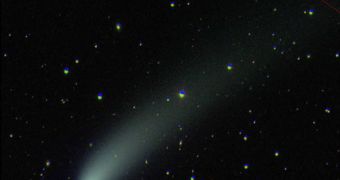According to a new scientific study, previous knowledge of how comets originate in the Kuiper's Belt, the exterior asteroid belt of our solar system, is wrong. The paper reveals that the “pathways” these celestial bodies use to get from their birth grounds in Earth's vicinity are fairly safe for our planet, and that the risk of collision is therefore smaller than previously anticipated. Writing in the July 31st issue of the journal Science, experts reveal that the chances of comets from Kuiper's Belt crossing Earth's orbit are very slim, and collision concerns should be set at ease.
On the other hand, if the new study turns out to be correct, it could mean that previous mass extinctions in the planet's history, such as the event that killed off the dinosaurs, might have not been caused by comets. Some experts have argued for a long time that there must have been other factors that led to mass extinctions, such as volcanic eruptions, but, overall, opinions on the matter have remained divided right down the middle. Future studies will be required to settle this matter.
Astronomers believe that rare comets, such as the ones that take hundreds to thousands of years to circle the Sun once, may originate from the Oort Cloud. This formation is made up of remnants from the nebula that led to the formation of our solar system, more than 4.5 billion years ago. It extends from 93 billion miles away from the Sun outwards, and is estimated to cover an area of three light-years. Scientists believe it is filled with rogue celestial bodies, which may have their orbits nudged from time to time, and thus make a pass through the inner solar system.
University of Washington graduate student Nathan Kaib says that one of the things we can rely on in assessing threat levels to our planet is the presence of Saturn and Jupiter, which are our “bodyguards.” “They cut down on the number of bodies reaching Earth-crossing orbits,” Kaib argues.
“The most powerful comet showers caused minor extinctions and other showers should have been less severe, so comet showers are probably not likely causes of mass extinction events,” he adds, referring to the three impacts that caused minor cataclysms on Earth, and occurred at close intervals, within about one million years. He argues that these impacts were caused by the largest comet shower possible in the solar system, and that, therefore, the larger extinctions were not generated by these comets. However, he mentions, other impactors from other sources could have caused them.
The expert also argues that Jupiter's new scar may have been caused by such a comet, coming from the inner Oort cloud, rather than the outer one. He says that the two planets avert comet impacts by manipulating them with their strong gravitational field, but that, once in a while, a comet slips through their grasp. When that happens, it either hits them, or moves further, towards the inner solar system. Kaib's work was sponsored by the National Science Foundation (NSF) and NASA, Space reports.

 14 DAY TRIAL //
14 DAY TRIAL //